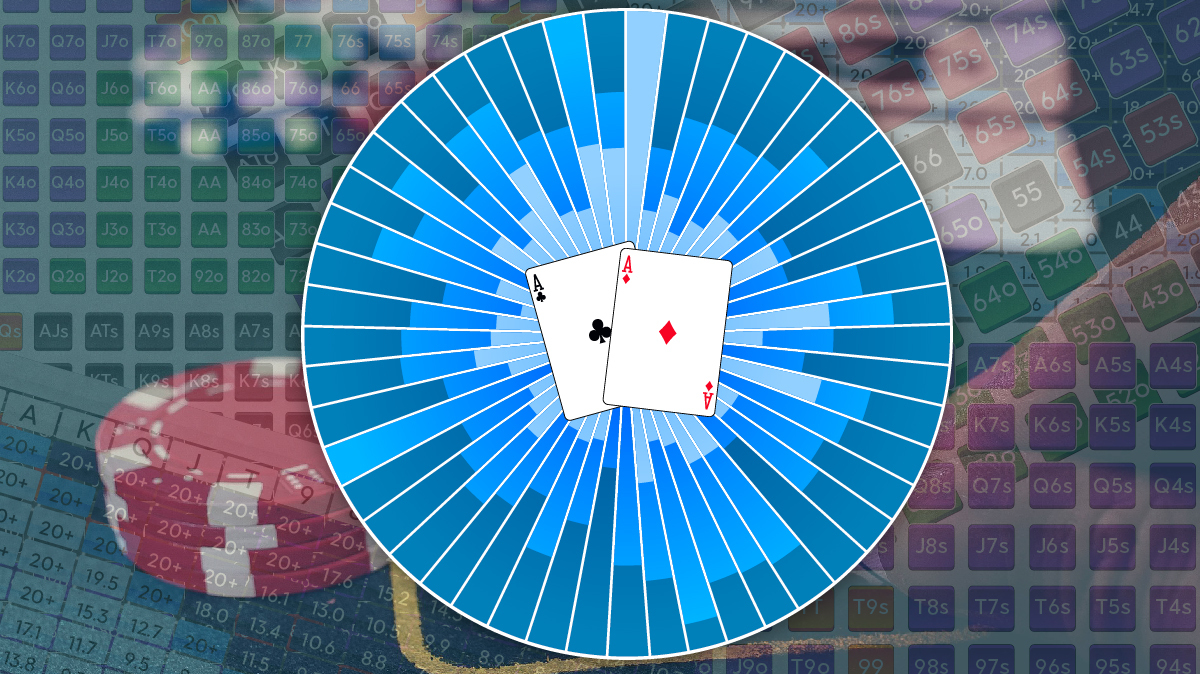Have you ever found yourself mid-game staring at your HUD while facing an open from a player with an RFI stat of 21% and thought to yourself, 'What hands are in his range?' Or while playing live, have you estimated that your opponent calls an open 40% of the time but didn't know what hands comprise that range?
Well, I'll show you the easy way to learn poker ranges for quick reference in the future.
First, here's a Poker Range Chromatic I created for my own use:
A cbet range of: QX, 2pair+, strong draws, and air would be considered a 'polarized range'. This is important to know to have the proper response. If you notice that someone's range is too heavily polarized, you would call with medium strength hands more often to beat the air portion of their range. Poker Range relates to a set of hands that either you or an opponent might hold in a particular situation. So, instead of thinking of one holding like J♣10♦, you would include several hands in a range. For example – K9s, Q9s, J9s, etc. – is part of a poker range of hands. This concept is what we call a range in poker.
I wanted to learn where each hand falls within a range and the above is what I came up with. I used Flopzilla to figure out which hands fall within each percentage grouping. I just started with a 5% range, then went by 5's up to 40%, then followed that with 10's up through 60% then 75%. I used color coding to help visualize the ranges.

I then took the following steps to learn the ranges:
- Printed the chromatic I made, laminated and posted it on the side of my computer monitor for quick in-game reference.
- Created 11 flash cards for use each night as part of my warm-up, and I put the following on them:
- For one week during my study session I would do a hand history review from the previous night's session and each time I faced an open I looked at their RFI Stat in that position and determined what range it fell under. I would say aloud, '20% in the CO… that's 22+, A7s+, ATo+, K9s+, KTo+, Q9s, QTo+, JTo and 98s+.' That's all there was to it. After that first week I got them all down. This is especially helpful when playing live as I can't glance to the side of my screen to get an estimate on an opp's range. Now, it's easier to remember the bottom of the ranges as you're trying to learn these. So, when thinking about 20%, the bottoms are 33, A7s, ATo, Q9s, JTo and 98s. If you just remember those 6 hands for 20%, you know it includes everything better than those. So if the question arises for a hand like K8s, you know that K9s is the bottom at 25% and K7s is the bottom of 30%, so it's within the 30% range and just under the 25% range.


I then took the following steps to learn the ranges:
- Printed the chromatic I made, laminated and posted it on the side of my computer monitor for quick in-game reference.
- Created 11 flash cards for use each night as part of my warm-up, and I put the following on them:
- For one week during my study session I would do a hand history review from the previous night's session and each time I faced an open I looked at their RFI Stat in that position and determined what range it fell under. I would say aloud, '20% in the CO… that's 22+, A7s+, ATo+, K9s+, KTo+, Q9s, QTo+, JTo and 98s+.' That's all there was to it. After that first week I got them all down. This is especially helpful when playing live as I can't glance to the side of my screen to get an estimate on an opp's range. Now, it's easier to remember the bottom of the ranges as you're trying to learn these. So, when thinking about 20%, the bottoms are 33, A7s, ATo, Q9s, JTo and 98s. If you just remember those 6 hands for 20%, you know it includes everything better than those. So if the question arises for a hand like K8s, you know that K9s is the bottom at 25% and K7s is the bottom of 30%, so it's within the 30% range and just under the 25% range.
Please let me know if you would make tweaks to these ranges as I always love feedback.
Poker Hand Ranges Explained Drills
Study hard and make your next session the best one yet!
Poker Hand Ranges Explained Chart
- The 12 Days of Christmas 2020 Podcast Episodes - December 14, 2020
- Strategies and Action Steps from the Quick Wins Poker Course - November 24, 2020
- How to Quickly Understand Online Tournament Players – Podcast #318 - November 18, 2020